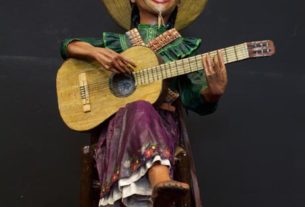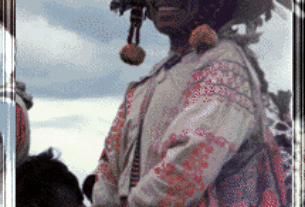March is the month Talpa de Allende receives hundreds of thousands of visitors who come to pay homage to the little twenty inch tall image of Our Lady of the Rosary, also known affectionately as La Chaparrita (the short one). They come from all parts of Mexico and most of them come walking, at least part of the way. To walk in is part of the tradition and I doubt it will ever change.
Apart from coming filled with devotion, many of them come with sore blistered feet, bad colds, sore throats, conjunctivitis and worse infirmities.
Generally speaking, hotel accommodations are plentiful in Talpa, but not in March. Town folks rent out sleeping space in their corrals, hallways and terraces. The going price of a straw mat thrown on the floor and the privilege to share a bathroom with fifteen or so other people is approximately $4.00 USD per person per night.
Very few visitors bring their own tents. Besides, there are no campgrounds and the nights can get rather chilly in March. Ignoring the chill, many take temporary shelter under trees along the river, which runs all the way down to the Pacific Ocean, joining up with the Mascota and Ameca Rivers, and emptying into the Bay of Banderas. They do their cooking, eating and sleeping alongside the river. They wash their dishes, clothes and even their bodies in the less-than-tepid water.
Health authorities and city maintenance are pushed to the limit during this fiesta month spraying disinfectants and tossing out shovels of white lime (cal) in certain spots. People are advised to wash down the entrances to their houses with a strong chlorine solution and to give their children extra vitamin C and yogurt. The day the last visiting bus leaves town, which is usually the week after Easter, a general good old-fashioned Spring Cleaning takes place. The main plaza, streets and store fronts are scrubbed clean with a sudsy solution and then hosed down from the water truck while the merchants run off to Puerto Vallarta, Tenacatita, San Blas, or some other beach town to rest and count the money they have earned during this hectic season and on which many of them will have to live until the next big fiesta month.
Now that I’ve bad-rapped Talpa’s biggest fiesta of the year, I’ve found a reason to share with you something I’ve wanted to share for a long time, and that is folklore that works.
In the summer of 1975, Margie, Brian and their boat Kayoka took safe harbor in Puerto Vallarta. We were young and fun was our game. We explored the countryside and picnicked on deserted beaches where high-rise condominiums now stand. We ate fish cooked on a stick over an open fire on the public beaches. We swam in the cool, clear, clean waters of Bahia de Banderas. The summer months passed all too quickly. In October of that year, after the tropical storms had abated, Margie and Brian headed back to the high sea. Their parting gift was a book I have cherished these many years. It is water marked, the pages have yellowed and the cover is a bit wobbly, but it is filled with folklore that works. I know. I’ve tried much of it over the past thirty-two years.
I have reason to believe Evelyn Winter might have been a resident in Guadalajara or in the Lake Chapala area in 1972. She wrote a book entitled Mexico’s Ancient and Native Remedies. She gives credit to her Mexican friends, neighbors, shopkeepers and garbage collectors who shared their ancient secrets with her. The following are just a few of the gems in her book.
Aches: “Take a bunch of small daisy-like yellow flowers called ‘árnica,’ which can be found in the fields in July, from vendors on the streets or from the herbalists when dried, and make an infusion with alcohol. The liquid becomes clear and green and can be kept in a decorative bottle on the dresser, night stand or in the bathroom. Rub on frequently where it aches.” (Maria Cervantes)
Keep in mind this book was written in 1972. I saw árnica cream three years ago in a Walgreen drugstore in Texas. I asked my cousin about it and she told me, “Oh, that is the latest thing on the market for aches and pains.”
Arthritis and Rheumatism: “A very old woman who lives by herself was badly crippled with rheumatism. She used to send her chauffeur to the police station with a bottle of cane alcohol. The police would fill it with marijuana. When it fermented, she rubbed the liquid on her aching joints. That was the only way she could get the marijuana.” (Anita Reyes)
Peyote works equally as well. I’ve sent my bottle of alcohol to the police station also. I could have asked my next door neighbor for the marijuana, but felt safer going to the police.
Blood Pressure (Low): “Mix lime juice with honey and drink it with a whole clove of garlic.” (Margarita Castellanos)
Two tablespoons of lime juice and the same amount of honey in a glass of water was prescribed by Dr. DeForest Jarvis, D.C. in his famous best-seller, Apple Cider Vinegar and Honey Cure, which hit the market in 1958. He prescribed that cure for just about any ailment you could think of. We traveled the back roads of Mexico in the early ’60s with a jar of honey and a bottle of a/c vinegar in our backpacks and never experienced Montezuma’s or anybody else’s revenge.
Blood Pressure (High): “Alpiste (canary grass) is a kind of birdseed that will bring blood press down immediately. It has not been revealed how much to take, so be careful with the dosage. And check with the vendor.” (Jeanette Patchin)
Hmmmmmm. I think I’ll stick with my cardiologist.
Bronchitis and Coughs: “Put a sliced onion in hot oil and leave until the onion has let out all the juice and looks dead. Apply a plaster of this to the chest and back.” (The Huichol Indians)
“Make a tea of bougainvillea blossoms; purple is best, and drink when you are thirsty.” (Maria Jimenez)
Gordolobo is a plant often recommended for making a brew to drink to fight the cough. It grows wild in the fields and I often see my neighbors picking it. It works, but the one I hear that is a sure cure is to soak your feet in your own urine. I’m not sure I could go for that, but this one I can vouch for: If you have a sore throat and feel a cold coming on, mash up some ripe tomatoes, heat them in a skillet and make a plaster to apply to the soles of your feet and go to bed. It is a good idea to wrap your feet in old rags and pull on plastic bags over your feet.
Earache: “Put mashed leaves of the planta ruda (rue) in your ear. It is also good to eat when mixed with chile.” (Alfonso Mendoza)
“Heat an ordinary geranium leaf, but do not dry it out or crisp it. Put it in your ear.” (Rosa Risso)
Eyes: “Make a tea of manzanilla (chamomile). Put a compress of cotton over the eyes to relieve tiredness and redness of the eyes.” (Celia Orozco)
“If you have something in your eye, take a hair from the tail of a live cat and use it to remove whatever is in the eye. It must be the static electricity that attracts it like a magnet.” (Norma Garcia)
After you pull a hair from the tail of a live cat, what would you use to put on the scratches you are liable to get?
“To rest the eyes: Put a drop of lemon juice in each eye. This can be done to new born babies too” (Anita Placencia)
Feet: “For tired aching feet, soak them in warm water to which wood ashes have been added.” (Marian Barlow)
Hair: “To rid the head of hair lice or the infection caused from scratching, cut all the hair off and cover the head with fresh cow’s excrement.” (Rosa Ortiz)
Pues, Señorita Ortiz, that remedy might get rid of the hair lice, but I think you’d probably lose a few friends also.
May the pilgrims walking to Talpa this month have a smooth journey, and take note of these free home remedies.


